Dario Lopez is a papier-maché mask maker. All nine of his children help in some part of the process in addition to their “day jobs”. One is a teacher, another a software engineer; one is a judge. He was most gracious with his hospitality and demonstration of how he makes his famous masks.
We made one stop for coconuts and fruit to take to the indigenous people of the Embera tribe tomorrow. When the fruit merchant learned where the fruit was going, he insisted on sending free watermelon and cantaloupes as well!
Back on the bus, Cathy was musing at the similarity between the Dirty Devils and the Kachina figures of the Hopi Indians. Roberto was fascinated and wanted me to write this down so he could research it further. Like a bonehead, I misspelled Kachina as Cochina which in Spanish slang means whore or slut…not exactly a reminder to be on your best behavior! A good laugh was shared by all.
We are now staying at the Holiday Inn right across from the Miraflores Locks on the Panama Canal. Upon arriving, we were served cold rum drinks while our bags were delivered to our room.
Once settled, we went on a brisk walk back into the woods within the compound of the original Panama Canal housing and operations.


Dario Lopez with the certificate he won from the government for being a national artist.
The main mask that Dario makes is a “Dirty Devil”, here modeled by his 19 year-old son. As in many cultures, a frightening visage like this appears at festivals and ceremonies as a folk figure who frightens young and old to behave and uphold values of the culture.

Sinovia gave us a great walking tour of Sarigua National Park.

The sisters got right into the photo op with the D.D.



Left - some of the smaller masks and painted paper plates for the tourists.
Right - A large poster showing Dario receiving his national award.

Mango trees grow everywhere.
School kids wait for their bus. All wear uniforms and benefit from the 4.2% education tax that every Panamanian pays. This tax also covers all university tuition except for $35/semester.

Almost all the buildings in the Panama Canal Zone conform to this architecture. Since administration of the Canal was returned to Panama by the U.S. in 2000, a lot of these buildings have been repurposed - hence, restaurants, banks, hotels, schools, etc.

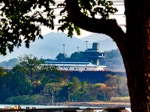
Miraflores Locks from our hotel window.
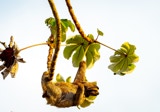
At first we missed this little fellow due to his superb camouflage.
Soon, however, he was stretching s…l….o…w…l…y to reach another cecropia leaf, and we had a full view.
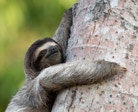
Yes, we instantly fell in love with this little juvenile, 3-toed sloth. Our luck was more than a casual sighting in the upper jungle branches, he was making his weekly visit to the ground to defecate before returning to his tree. They are very vulnerable while on the ground becoming food for jaguars, coyotes, and feral dogs. A sloth could barely outrun a snail!
Birds
I know that many of you are not into birds…maybe the frigate love fest was plenty enough for you. So, if birds are not your thing, scroll quickly to the bottom and continue your journey through the other treasures of Panama.
If, however, you are amazed as we were by the number and variety (1037 separate species of birds in Panama - 1/10th of the world’s bird population concentrated in this small country) then scroll slowly and appreciate the small sample my camera was able to supply.
It’s likely that we have misidentified many of these beauties, and so we’d appreciate corrections from those of you with the special talents for bird identification. I’m sure birds are no happier to be mistaken for someone else than we are.

This Keel-billed toucan was the most important bird I hoped to photograph in Panama. The magnificent quetzals were a bonus of our pre-excursion trip, but were in flight at a distance. This guy was in my range and happy to pose.


Smaller and not so flashy were these warblers. Here a female yellow warbler…
…and here a migrant adult male yellow warbler.

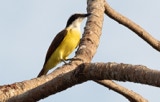
Common Tody-Flycatcher
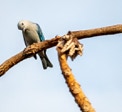
Blue-gray tanager
Female red-throated Ant-tanager
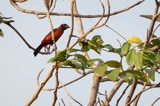

Gray-capped cuckoo

Pale-vented pigeon


We are still amazed at the variety of animals we were able to see and photograph within two blocks of our hotel. This is a bustling urban community with speeding cars, honking horns, loud conversation, and most of these animals were discovered right next door to an energetic elementary school!
Yellow-headed caracara